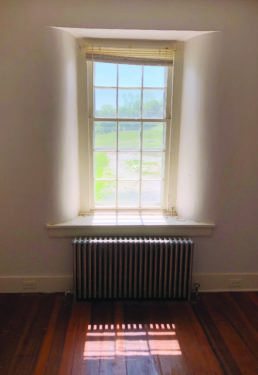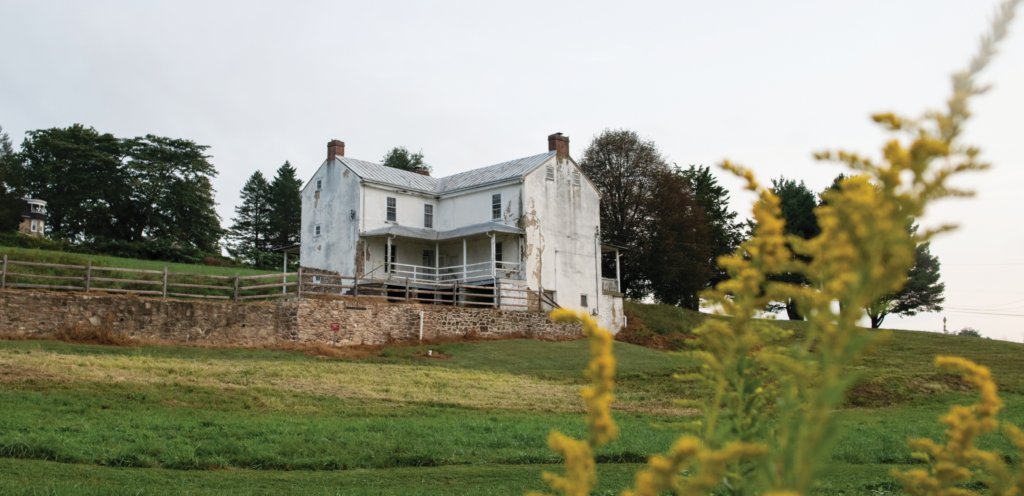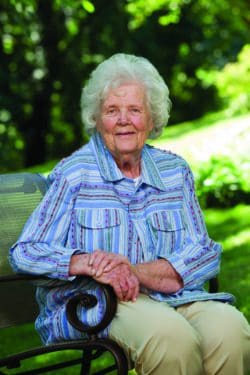new life for the Ralston house.
A visit to Bryn Coed Preserve is a picture postcard of the best of Chester County: rolling woodlands, meadows, and farm fields stretch for miles. Bald Eagles ride the thermals in slow, graceful circles, and songbirds chatter in the trees.
This land has been inhabited for more than 10,000 years, originally by the Lenape and, more recently, by European settlers who found the county’s rich soil ideal for farming. As a result, the landscape’s natural beauty is complemented by picturesque farmhouses and barns.
 “Natural Lands’ mission is saving land, not saving buildings,” said Scott Wendle, vice president of preserve stewardship. “But buildings often accompany and complement the land we conserve, so we carefully evaluate structures to determine their best use. Occasionally we create a small lot that includes a residence and then sell that parcel to help support the ongoing care of a larger preserve. Sometimes, especially when a building has cultural or historical significance, we restore the building to enhance the beauty and function of the preserve.”
“Natural Lands’ mission is saving land, not saving buildings,” said Scott Wendle, vice president of preserve stewardship. “But buildings often accompany and complement the land we conserve, so we carefully evaluate structures to determine their best use. Occasionally we create a small lot that includes a residence and then sell that parcel to help support the ongoing care of a larger preserve. Sometimes, especially when a building has cultural or historical significance, we restore the building to enhance the beauty and function of the preserve.”
When Natural Lands purchased Bryn Coed Farms in 2016 to save its 1,505 acres from significant development, the property contained 15 farmhouses, 13 barns, and 40 other outbuildings. All but one of these buildings have been sold as part of the conservation easement parcels that make up the Bryn Coed Conservation Community. The remaining structure, the early 19th-century Ralston House, is within the boundaries of the 520-acre Bryn Coed Preserve and has sat unoccupied for several years.
Now, thanks to an extraordinary gift from long-time Natural Lands friend and supporter Penny Wilson,
this historical farmhouse will undergo a complete restoration. The house was constructed between 1800 and 1820 by Major Robert Ralston, a prosperous farmer and lawyer. It was one of the largest homes in the township and was built on the site of an earlier log house that appeared on tax rolls in 1798.
By today’s standards, the Ralston house is modest, just 1,950 square feet. But this home was part of a significant local trend towards building larger, costlier structures that began after the Callowhill Manor case in 1790. Robert Ralston and his son John played instrumental roles as attorneys in this case against the descendants of William Penn, who still laid claim to the land. The decision allowed residents to obtain legal title to the farms they had worked as tenants for decades.

The homestead remained in the Ralston family for more than a century until 1928. In 1944, it was subdivided and sold, representing the first change in the property’s boundaries since the farm’s establishment. In
1956, the Buckwalter Turkey Farm reunited the parcels; a little more than a decade later, the farmer sold the land to Ludens, Inc. and it became part of Bryn Coed Farms.
The Ralston House was built on a center-hall plan with symmetrical rooms on each side and an additional rear “ell,” which was the kitchen wing. Though in need of updating and modern systems, it is structurally stable and includes many original details, such as mantels, random-width flooring, and doors.
“Remarkably, the interior of the house has retained its structural and historical integrity,” said Peter Zimmerman, a member of Natural Lands’ President’s Council and professional architect who is overseeing the Ralston House renovations.
While the building is in surprisingly good condition, it has been vacant for some time. “There was quite a
bit of deferred maintenance over the years,” said Steve Longenecker, director of building stewardship.
“Given the history of this property, we don’t just want to renovate the house. We want to restore it.”
Major work will focus on removing the stucco and repointing the original stone façade; installing a new septic system; upgrading heating, plumbing, and electrical systems; renovating the kitchen and bathrooms; and replacing the roof and windows.
All work will be conducted with sensitivity to the historical nature of the building. Additionally, Natural Lands is working with the West Vincent Township Historical Commission, which has already documented and photographed the farmhouse and outbuildings.
Sub-contractors will do the bulk of the work, but Natural Lands’ talented building stewardship staff will lend their skills to portions of the Ralston House project. They have an outstanding track record; most
recently, the team finished a six-year complete restoration of an 1817
farmhouse at Crow’s Nest Preserve, just about 10 miles north-east of Bryn Coed. Highlights of their work
on that building include uncovering and restoring the walk-in fireplace and chimney, hand-forging all the
door hinges and latches, and painstaking stripping of two centuries of paint to restore original millwork.
Perhaps most importantly, the restoration of the Ralston House, like other historical structures Natural Lands owns and cares for, will serve a pragmatic purpose: the farmhouse will be both home and “home base” for stewardship staff, allowing better oversight of Bryn Coed Preserve.
“Since opening to the public in 2018, Bryn Coed has quickly become one of our most visited nature preserves,” said Scott Wendle. “It requires a lot of staff hours to keep up with the day-to-day preserve maintenance, not to mention all the improvements—installing parking lots, creating rain gardens, planting
thousands of trees, building bridges, expanding the trail system—that Preserve Manager Darin Groff, Assistant Manager Caleb Arrowood, and others have to do there. Having a staff person on site at the Ralston homestead—which will be their office and home—will be a tremendous benefit and improve operational efficiency at Bryn Coed.”
“We’re not in the business of acquiring land to save the buildings, but we can save buildings to service
the land,” said Longenecker. “I am thoroughly enjoying the opportunity to work on this exciting project— which restores and adapts a significant historical structure, preserves a piece of Chester County’s past, and serves the Natural Lands mission. Thank you to Penny Wilson for making it all possible!”
The Ralston House restoration is projected to be completed in fall of 2021.
transformational support.
“When I think about Penny Wilson’s decades-long philanthropic investment in Natural Lands, two words come to the fore: inspired and transformational,” said Natural Lands president Oliver Bass. “She is one-of-a kind.”
Over the last 15 years, Penny has provided leadership gifts that have anchored campaigns to expand our headquarters, build endowment for unendowed and under-endowed preserves, and extend organizational capacity for stewarding natural resources and connecting people to the outdoors—all transformational.
 But just as importantly, Penny’s leadership—sometimes in the form of outright challenges and other times as distinguished example—has inspired others. “It is hard to overstate the impact that Penny has had on our fundraising,” shared Ann Hausmann, vice president of development. “She has helped lay foundations—both literally and figuratively—that will safeguard our mission into the future.”
But just as importantly, Penny’s leadership—sometimes in the form of outright challenges and other times as distinguished example—has inspired others. “It is hard to overstate the impact that Penny has had on our fundraising,” shared Ann Hausmann, vice president of development. “She has helped lay foundations—both literally and figuratively—that will safeguard our mission into the future.”
Penny’s most recent act of generosity has made it possible for us to restore the Ralston House at Bryn Coed Preserve, including endowment to guarantee its ongoing maintenance. “I have a passion for the natural and built historic world,” said Penny. “It has been gratifying for me to partner with Natural Lands over the years to ensure the preservation of both. I couldn’t be more excited about the Ralston House restoration, but I’ve seen the project list and there is much more to do at Bryn Coed Preserve. I hope my commitment to this special property will encourage others to share their support as well.”
If you would like to learn more about preserve infrastructure gift opportunities at Bryn Coed, please contact Ann Hausmann at hausmann@natlands.org.
